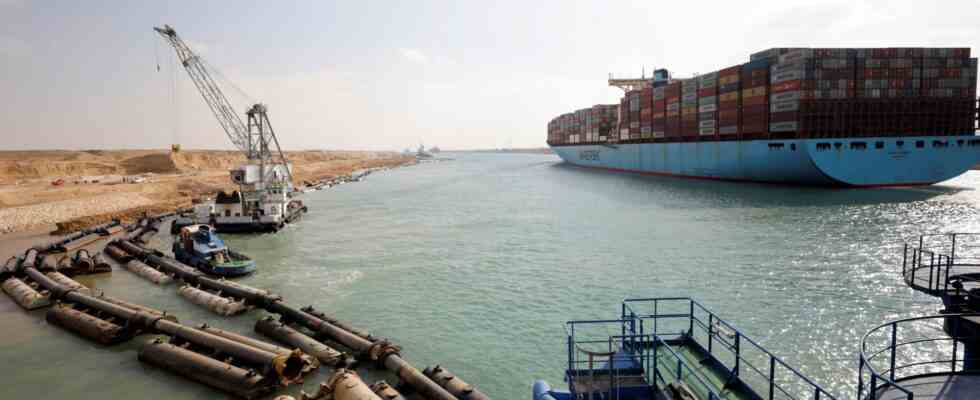Status: 03/23/2022 03:03 am
A ship stood across – and the ferry service in the Suez Canal came to a standstill: after the accident on the “Ever Given” a year ago, the canal is being deepened and expanded under high pressure – while operations continue.
The gigantic shovel of the dredger lifts 3,600 cubic meters of sand and rock from the bottom of the canal per hour. The rubble is then sucked off via black pipes and deposited in the desert. Two brand new high-tech excavators from the Netherlands are permanently in use.
The Suez Canal is to be widened by 40 centimeters and deepened by up to 22 centimeters in the southern section between km 132 and 162. “They’re the best excavators in the entire Middle East,” says Canal Authority chief Osama Rabie.
13 billion cubic meters of sand have already been excavated since May last year. Huge container ships should thus be able to navigate more safely through the bottleneck between the Mediterranean and the Red Sea and be less susceptible to currents and winds.
Up to 100 ships at the same time in the future
In addition, a branch of the canal will be extended by ten kilometers to 82 kilometers. This allows six more ships to pass through the waterway – it would then be more than 100 ships at the same time; none of them should take longer than eleven hours for the transit.
The project is expected to be completed in two years, earlier than originally planned. The construction work should not affect shipping. “So far we haven’t seen any major problems. The project is progressing well,” Rabie assures ARD studio Cairo during a viewing appointment on one of the two dredgers near the city of Suez.
Other ships suck up the sand at the bottom of the canal to make more room.
Image: ARD Studio Cairo
Average shock has an effect
The aim should be to prevent an accident like that of the container freighter “Ever Given” at the end of March 2021 at any price. The world’s largest freighter ran aground very close to the construction site and blocked the canal for six days.
Almost 400 ships were backed up and supply chains were interrupted. The consequences were also felt at the ports of Hamburg, Rotterdam and Antwerp.
13 percent of the world trade volume runs through the Suez Canal. Almost all container ships between Germany and China pass through the waterway – about nine percent of all German goods imports.
A flash tide solves the blockade
Because of the corona pandemic, the global supply chains were already at the limit. The accident dealt another blow to world trade. After a spring tide, tugboats were finally able to uncover the “Ever Given”. The world breathed.
The causes are not entirely clear to this day. The canal authority suspects human error: the giant freighter drove through the canal at too high a speed in strong winds.
The Egyptian authorities spent months negotiating compensation payments with the Japanese owner Shoei Kisen. They say they suffered 80 million euros in damage. An agreement was finally reached, the details of which both sides agreed not to disclose.
Suez Canal on record course
Since then, shipping through the canal has picked up speed again and is on record course. With 5.5 billion euros, the canal company recorded the highest income it has ever achieved for the past year. 20,694 ships passed through the canal, an average of 56 per day.
In order to be able to continue the success story, the expansion work in the south is now in full swing. “Because of the accident, we decided to speed up the project,” says Osama Rabie from the canal company. Time is money, that’s true in hardly any other industry as much as in logistics – the global corporations are in fierce competition. The bottleneck through Egypt should also play an important role in the future.

